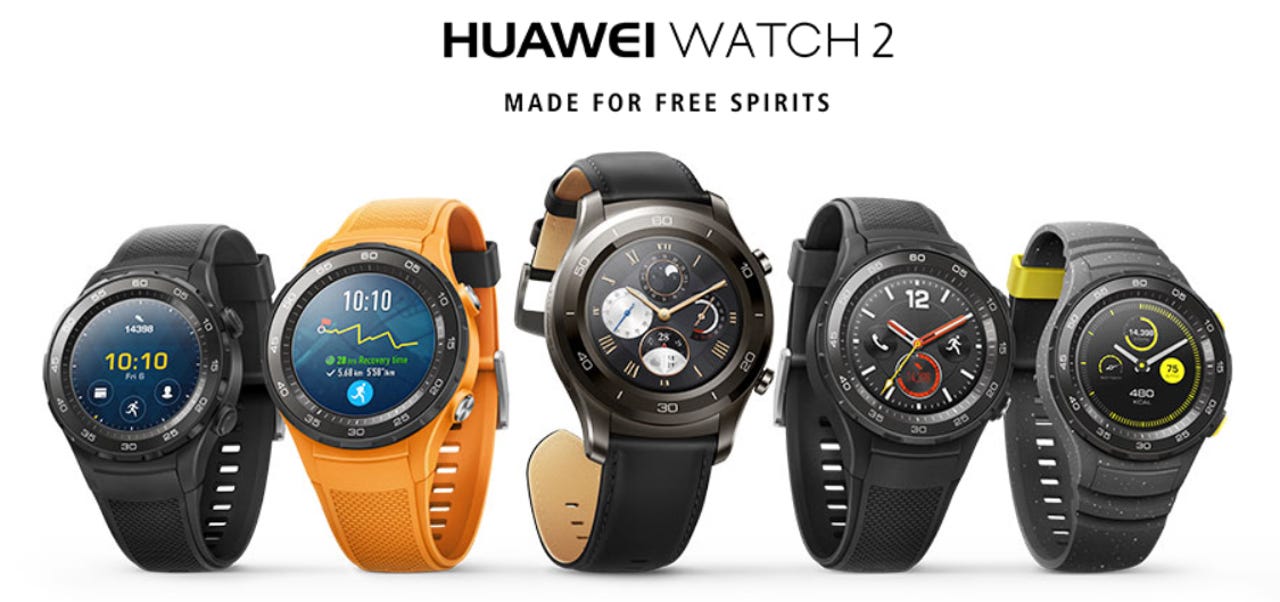Huawei unveils the Watch 2, Watch 2 Classic

Chinese technology giant Huawei unveiled its new smartwatches, the Watch 2 and Watch 2 Classic, at Mobile World Congress (MWC) in Barcelona on Sunday.
The two new smartwatches feature a 1.2-inch 390x390 326ppi circular Corning Gorilla Glass AMOLED display; a Qualcomm 1.1GHz CPU; 4GB of Flash memory; 768MB of RAM; GPS; 2.4GHz Bluetooth 4.1; a three-axis gyroscope, a three-axis compass, a three-axis A&G sensor, a heart rate sensor, a barometer, a capacitive sensor, and an ambient light sensor; a 420mAh battery; and an IP68 water and dust resistance rating, with the watches operating on Android Wear 2.0.
Huawei's Watch 2 comes in orange, black, and grey with a sport strap, while the Watch 2 Classic comes in grey with a leather strap.

Huawei's new smartwatches follow the launch of its Fitbit Blaze competitor the Huawei Fit last year, which featured a 1.04-inch, 208x208 LCD touchscreen display with Gorilla Glass 3; 256MB of RAM; 16GB of internal storage; Bluetooth 4.2; a six-axis motion sensor, optical heart rate sensor, capacitive sensor, and ambient light sensor; an 80mAh battery that lasts six days; and 5ATM water resistance.
MWC 2022
Earlier this month, Canalys revealed that Apple shipped an estimated 11.9 million smartwatches during 2016, accounting for around 50 percent of global market share, with Xiaomi shipping an estimated 5.5 million Mi Bands. The Samsung Gear S3 and LG Watch are also expected to bounce back and provide more Android alternatives and greater competition in the sector.
In regards to the smartwatch industry, analyst group Juniper has predicted a compound annual growth rate (CAGR) of 13 percent, to reach $21.5 billion per year by 2021.
According to market research firm Kantar, just 4.7 percent of US consumers owned a smartwatch as of September last year, compared to 3.2 percent of consumers in Europe's four largest economies (EU4) -- Germany, the United Kingdom, France, and Italy.
Apple makes up 32 percent of all wearable sales in EU4 and 33 percent in the US, attracting consumers with the GPS and waterproofing of the Apple Watch Series 2, along with the upgraded Series 1 with a lower price point, according to Kantar.
Technology industry analyst firm Telsyte in September similarly revealed that in Australia, smartwatches account for a third of all smart wearables, with sales of smartwatches increasing by 89 percent year on year during the first half of 2016.
The Apple Watch also leads in Australia, holding down more than 50 percent of smart wearables market share, followed by the Samsung Gear and the Fitbit Blaze.
The growth in smartwatches was attributed by Telsyte to uptake of mobile contactless payments through Android Pay, Apple Pay, and Samsung Pay using a smartwatch; a reduction in pricing; increased availability; improved designs; and usage of health and fitness apps.
Telsyte has predicted smart wearables to be worn by 37 percent of all Australians as of 2020, with growth to be driven by Apple's second-generation watch, along with greater uptake of mobile payments and the lower cost of units.
Disclosure: Corinne Reichert attended Mobile World Congress 2017 in Barcelona as a guest of Huawei